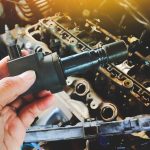An old engine can still have a lot of life left in it if you’re willing to put in the work. Engine rebuilding is a process that breathes new vitality into worn-out engines, restoring them to near-new performance and reliability. Whether you’re a car enthusiast aiming to preserve a classic or simply looking to avoid the cost of a full engine replacement, rebuilding an old engine can be a rewarding and cost-effective option. In this guide, we’ll take a closer look at the fundamentals of engine rebuilding, the reasons to consider it, and the steps involved in giving your old engine a fresh start.
Why Rebuild an Old Engine?
For many vehicle owners, engine rebuilding might seem like a daunting task, but it offers several compelling advantages. First and foremost, rebuilding an old engine allows you to restore your car’s performance without the expense of purchasing a brand-new engine. Engine replacements are typically far more expensive than rebuilds, particularly for classic or rare vehicles where finding a compatible new engine might be difficult or prohibitively costly.
Another reason to consider rebuilding is environmental impact. Recycling your engine’s core components reduces the need for new parts and minimizes waste, making rebuilding a more sustainable option. Additionally, many car enthusiasts choose to rebuild engines for sentimental reasons. If you’ve grown attached to your vehicle, rebuilding the engine can keep it running for years to come, maintaining its original essence rather than starting from scratch with a new car.
Finally, rebuilding an old engine gives you the opportunity to enhance performance. During the rebuilding process, you can replace worn-out parts with high-performance components, resulting in a more efficient and powerful engine than the original. This is particularly beneficial for those who want to boost horsepower, improve fuel efficiency, or enhance the overall driving experience.
Assessing Your Old Engine: Is Rebuilding the Right Option?
Before diving into the rebuilding process, it’s crucial to assess the condition of your old engine to determine whether rebuilding is a feasible option. Some engines may be too damaged to warrant a rebuild, while others may simply require a few key repairs.
Signs that your engine may need rebuilding include excessive oil consumption, low compression, knocking or rattling noises, poor fuel efficiency, and loss of power. If your engine is consistently producing strange sounds, emitting excessive smoke, or struggling to maintain performance, it’s a good indication that something is seriously wrong internally.
However, not every engine problem necessitates a full rebuild. In some cases, you might be able to address issues with simpler repairs, such as replacing gaskets, valves, or spark plugs. A full engine rebuild is typically recommended when the internal components, such as the crankshaft, pistons, or camshaft, are worn beyond repair or when there’s significant internal damage due to overheating, oil deprivation, or wear and tear over time.
A professional inspection by a trusted mechanic or engine specialist can help you determine whether rebuilding is the best option for your old engine. They’ll be able to diagnose the root cause of engine problems and recommend the most appropriate course of action.
The Engine Rebuilding Process: Step-by-Step Overview
Rebuilding an old engine involves disassembling the entire engine, inspecting and cleaning all components, replacing worn or damaged parts, and reassembling the engine to factory specifications. This intricate process requires precision, patience, and the right tools to ensure that everything fits together perfectly. Here’s an overview of the key steps involved in engine rebuilding.
1. Disassembly and Inspection
The first step in rebuilding an old engine is to remove the engine from the vehicle and disassemble it completely. This involves taking apart every major component, including the cylinder head, pistons, crankshaft, camshaft, and connecting rods. Once disassembled, each part is thoroughly inspected for wear, cracks, or damage.
The block and head are key areas of focus, as any cracks or warping here can render the engine unusable. The pistons and cylinders are also inspected for scoring or excessive wear, and measurements are taken to ensure that the components meet manufacturer specifications.
2. Cleaning and Machining
After disassembly and inspection, the next step is to clean the engine components thoroughly. Over time, old engines accumulate carbon deposits, oil sludge, and grime, which can affect performance. Components are cleaned using specialized equipment, such as hot tanks, chemical baths, or ultrasonic cleaners, to remove all debris and buildup.
If any parts are out of specification or show signs of wear, they may require machining or replacement. For example, cylinder bores may need to be honed or bored to ensure a proper seal with new piston rings. The crankshaft journals may be ground down to a uniform surface, or valve seats may be reconditioned to improve airflow and sealing.
3. Replacing Worn Parts
Rebuilding an old engine often requires replacing several key components that wear out over time. Commonly replaced parts include piston rings, bearings, gaskets, seals, and timing belts or chains. These parts ensure the engine can operate smoothly and prevent issues like oil leaks or compression loss.
It’s also an excellent time to consider upgrading certain components for better performance. For instance, high-performance pistons or connecting rods can increase the durability and power of your engine. Upgrading the camshaft or installing a new performance intake and exhaust system can improve airflow and boost horsepower.
4. Reassembly
Once all components have been cleaned, machined, and replaced as necessary, the engine is ready for reassembly. Reassembling an engine requires careful attention to detail, as even minor misalignments can result in poor performance or engine failure. Precision torque specifications must be followed when tightening bolts and fasteners, and all components must be properly lubricated to prevent friction and wear during startup.
At this stage, timing is also set to ensure that the engine’s valves and pistons move in harmony. Proper timing is critical for the engine to function correctly and efficiently, so double-checking the timing marks and adjustments is essential.
5. Testing and Break-In
Once reassembled, the old engine is installed back into the vehicle for testing. The engine is initially run at low speeds to check for oil leaks, compression issues, or unusual sounds. If everything checks out, the engine undergoes a break-in period where it’s gradually brought up to normal operating speeds and loads. This break-in process allows new parts, such as piston rings and bearings, to wear in properly and ensure long-term performance.
After the break-in period, the engine is ready to return to regular driving conditions, with all the benefits of a freshly rebuilt powertrain.
Read More: Car Entertainment System History: A Road Trip Through Time
Common Mistakes to Avoid in Engine Rebuilding
Rebuilding an old engine is a complex process, and mistakes can be costly. One of the most common errors is failing to inspect and measure all components properly before reassembly. Skipping this critical step can lead to mismatched parts, poor fitment, or even catastrophic engine failure.
Another mistake is overlooking small parts such as seals, gaskets, or O-rings. These small but essential components ensure that no leaks occur and that the engine maintains proper compression. Always replace these parts during a rebuild, even if they appear to be in good condition.
Improper lubrication is another potential pitfall. Engines rely on proper lubrication to prevent excessive wear and heat buildup. Failing to lubricate key components during reassembly or using the wrong type of oil can result in engine damage shortly after startup.
Finally, rushing the break-in period can lead to premature wear on new components. It’s important to be patient during this phase, gradually increasing the engine’s speed and load over time to allow everything to settle into place.
The Benefits of a Rebuilt Old Engine
Rebuilding an old engine offers numerous advantages, from cost savings to improved performance. A rebuilt engine can last as long as a new engine, providing reliable service for many years to come. Additionally, rebuilding allows you to customize your engine to meet your specific driving needs, whether that means improving fuel efficiency or boosting horsepower.
Another significant benefit is the satisfaction that comes from breathing new life into an old engine. For car enthusiasts, the process of rebuilding can be incredibly rewarding, as you get to see the transformation firsthand and take pride in restoring a key component of your vehicle.
Extending the Life of Your Rebuilt Engine
Once your old engine has been rebuilt, proper maintenance is essential to ensure it continues running smoothly for years. Regular oil changes, routine inspections, and addressing minor issues as they arise are key to extending the lifespan of your rebuilt engine. Staying on top of maintenance tasks will help prevent further wear and keep your engine in top condition.
Rebuilding an engine is no small task, but with the right skills, tools, and attention to detail, it’s possible to give your old engine a new lease on life. Whether you’re doing it yourself or entrusting the job to a professional, engine rebuilding is a practical and rewarding way to keep your car running at its best.











